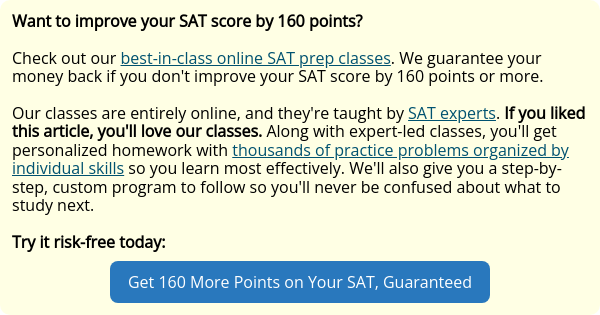
Are you struggling with an SAT Evidence-Based Reading and Writing (EBRW) score between 300 and 500? You're not alone—hundreds of thousands of students are scoring in this range. But many don't know the best ways to break out of this score range and get a 600 or higher.
Here, we'll discuss how to improve your SAT Reading score specifically and why it's so important to do so. Unlike other fluffy articles out there, we'll be focusing on actionable strategies. Put these eight strategies to work and I'm confident you'll be able to improve your SAT Reading score.
UPDATE: This article discusses a previous version of the SAT. If you are looking to raise your score on the digital SAT, check out my guide to getting an 600 on SAT Reading and Writing.
Brief note: this article is suited for students scoring below 600 on EBRW. If you're already above this range, my perfect SAT Reading score article is more appropriate for you.
Also, the current SAT (as opposed to the old SAT) has a single 800 Reading and Writing score, which combines your individual Reading and Writing test scores. So technically, when I talk about a 600 Reading test score, I'm referring to a 30/40 Reading test score, which combines with your Writing test score to get you 600. In this guide, I'll use 600 and 30 interchangeably to mean the same thing. We won't talk about Writing here, but if you want to improve your Writing score, too, check out my guide on how to raise your low SAT Writing score.
In this article, I'm going to discuss why scoring high is a good idea, address what it takes to score a 600, and then go into specific SAT Reading tips and strategies.
Stick with me—this is like building a house. First, you need to lay a good foundation before putting up the walls and pretty windows. In the same vein, we need to understand why you're doing what you're doing before we dive into our top tips and strategies for SAT Reading.
Note that I will talk mainly about getting to 600, but if your goal is 500 or lower, these concepts still equally apply.
Before we begin, here is the table of contents for this article in case you want to come back to this later or jump around:
- Raising Your SAT Reading Score: Understand the Stakes
- Know That You Can Get a 600 SAT Reading Score
- What It Takes to Get a 600 (or 30) in SAT Reading
- Strategy 1: Save Time on Reading Passages by Switching Your Reading Strategy
- Strategy 2: Learn to Eliminate the 3 Wrong Answers
- Strategy 3: Find Your Reading Skill Weaknesses and Drill Them
- Strategy 4: Only Use High-Quality SAT Reading Sources
- Strategy 5: Don't Focus On Vocab
- Strategy 6: Skip the Most Difficult, Time-Consuming Questions
- Strategy 7: Understand All Your Reading Mistakes
- Strategy 8: Guess on Every Question You Don't Know
Raising Your SAT Reading Score: Understand the Stakes
At this SAT score range, improving your low SAT EBRW score to a score in at least the 600 range will dramatically boost your chances of getting into better colleges.
Let's use Penn State University as an example. The average SAT score for admitted applicants to Penn State is 1270. Its 25th percentile score is 1180, and its 75th percentile score is 1370.
Furthermore, its acceptance rate is 51%. In other words, a little more than half of all applicants are admitted. But the lower your SAT scores are, the worse your chances of getting in will be.
In our analysis, if you score around 1000, your chance of admission drops to just 27%.
But if you raise your score to 1200, your chance of admission goes up to 60%—that's a really good chance of admission!
So improving your score by just 200 points makes a huge difference in your chances of getting into your target colleges.
For the SAT Reading section, this is especially true if you want to apply to humanities majors and programs, such as English or communications. These programs expect your Reading score to be strong. If you score low, they'll doubt your ability to do college-level humanities work.
Even if you're a math superstar and are applying to a science major, colleges still want to know that you can process difficult texts at a college level. A low Reading score will cast huge doubt on you.
It's really worth your time to improve your SAT Reading score. Hour for hour, it's the best thing you can do to raise your chance of getting into college.
Curious what chances you have with a 1200 SAT score? Check out our expert college admissions guide for an 1200 SAT score.

Know That You Can Get a 600 SAT Reading Score
This isn't just supposed to be a vague, happy-go-lucky message you see on a juice carton.
I mean, literally, you and every other student can do this.
In my job here at PrepScholar, I've worked with thousands of students scoring in the lower ranges of 300-500 on EBRW.
Time after time, I've seen students beat themselves up over their low scores; they think improving them is impossible and say things such as the following:
"I know I'm not smart."
"I just can't read passages quickly, and I don't know how to improve my SAT Reading score."
"I was never good at English, and my English teachers never told me I did a good job."
This breaks my heart.
Because I know that more than anything else, your SAT score is a reflection of how hard you work and how smartly you study.
Not your IQ and not your school grades. Not how Mr. Anderson in 10th grade gave you a C on your essay.
The truth is that SAT Reading is designed to trick you—and you need to learn how.
Here's why: the SAT is a weird test. When you take it, don't you get the sense that the questions are nothing like what you've seen in high school?
I bet you've had this problem: with SAT Reading passages, you often miss questions because of an "unlucky guess." You try to eliminate a few answer choices, but the ones left all sound equally good to you.
So you throw up your hands and take a random guess.
The SAT is purposely designed this way to confuse you. Literally millions of other students have the exact same problem you do. And the SAT knows this.
Normally, in your high school English class, your teacher tells you that all interpretations of a text are valid. You can write an essay about anything you want, and English teachers aren't allowed to tell you your opinion is wrong. This is because they can get in trouble for telling you what to think.
But the SAT has an entirely different problem. It's a national test, which means it needs to create a level playing field for all students around the country. It needs to fairly compare students with each other. As a result, every question must have a single, unambiguously, 100% correct answer.
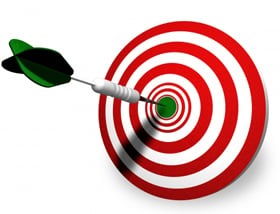
There's only ever one correct answer. Find a way to eliminate the three incorrect answer choices.
Imagine if this weren't the case. Imagine each Reading answer had two answer choices that might each be plausibly correct. When SAT scores came out, every single student who got the question wrong would more than likely complain to the College Board that the test is flawed. The College Board would then have to invalidate that question, ultimately weakening the power of the SAT.
The College Board wants to avoid this nightmare scenario. Therefore, every single Reading passage question has only one correct answer.
But the SAT disguises this fact by asking questions with the following cryptic phrases:
- The author would most likely agree with which of the following statements?
- The first paragraph primarily serves to:
- In line 20, "dark" most nearly means:
Notice a pattern here? The SAT always disguises the fact that there's just one unambiguous answer. It tries to make you waver between two or three answer choices that all sound plausible.
And then you guess randomly.
And then you get the question wrong.
You can bet students fall for this. Millions of times every year.
Students who don't prepare for the SAT in the right way don't appreciate this. But if you prepare for the SAT in the right way, you'll learn the tricks the SAT plays on you. And you'll raise your score.
The SAT Reading section is full of patterns like these. To improve your score, you just need to do the following:
- Learn the types of questions the SAT tests, such as the ones above
- Learn strategies to solve these questions, using skills you already know
- Practice with a lot of high-quality questions so you can learn from your mistakes
The point is that you can learn these skills, even if you don't consider yourself a good reader or a great English student. I'll go into more detail about exactly how to do this later.
But first, let's see how many questions you need to get right in order to get a 600 on SAT Reading.
What It Takes to Get a 600 (or 30) in SAT Reading
If you have a target score in mind, it helps to understand how many question you'll need to get right, which is known as your raw score, in order to hit your target scaled score (out of 600). Since SAT Reading combines with Writing to give you a single EBRW score out of 600, we're going to be looking at Reading test scores instead. In this case, we're aiming for a Reading test score of 30, out of 40 total points.
Here's a rough raw-score-to-SAT-Reading-test-score conversion table — the exact conversions will depend on the test, but this chart will give you a close approximation of how many questions you can miss and still get a 30. (If you could use a refresher on how the SAT is scored and how raw scores are calculated, read this guide.)
| Raw | Scaled | Raw | Scaled | Raw | Scaled | Raw | Scaled |
| 52 | 40 | 38 | 31 | 24 | 24 | 10 | 17 |
| 51 | 39 | 37 | 30 | 23 | 24 | 9 | 16 |
| 50 | 39 | 36 | 30 | 22 | 23 | 8 | 16 |
| 49 | 38 | 35 | 29 | 21 | 23 | 7 | 15 |
| 48 | 37 | 34 | 29 | 20 | 23 | 6 | 14 |
| 47 | 36 | 33 | 28 | 19 | 22 | 5 | 13 |
| 46 | 35 | 32 | 28 | 18 | 22 | 4 | 12 |
| 45 | 35 | 31 | 28 | 17 | 21 | 3 | 11 |
| 44 | 34 | 30 | 27 | 16 | 21 | 2 | 10 |
| 43 | 33 | 29 | 27 | 15 | 20 | 1 | 10 |
| 42 | 33 | 28 | 26 | 14 | 20 | 0 | 10 |
| 41 | 32 | 27 | 26 | 13 | 19 | ||
| 40 | 32 | 26 | 25 | 12 | 18 | ||
| 39 | 31 | 25 | 25 | 11 | 18 |
Source: SAT Official Practice Test #4
Notice that if you're aiming for 600 overall and 30/40 on Reading, you'll need a raw score of about 36/52. This is a 70% score.
This fact has serious implications for your testing strategy. In essence, you only need to answer about 2/3 of all Reading questions right. We'll go into more detail below about what this means for your testing strategy.
Whatever you're scoring now, take note of the difference you need to get to 30. For example, if you're scoring 23, you'll need to answer about 15 more questions right on Reading to get to 30.
Once again, even if your goal is something like 500 (i.e., 25/40), the same analysis applies.
OK, so we've covered why scoring a higher SAT Reading score is important, why you are capable of improving your score, and the raw score you'll need to get in order to hit your target score. I hope a lot of this was useful and changed how you think about SAT Reading prep.
Now, we'll look at actionable strategies you should use in your own SAT prep to maximize your Reading score improvement.
8 Strategies to Improve Your Low SAT Reading Score
In this section, we give you our top eight SAT Reading strategies guaranteed to improve your low Reading score.
Strategy 1: Save Time on Reading Passages by Switching Your Reading Strategy
Based on my experience working with thousands of students, by far the most common problem test takers have with SAT Reading passages is this: they keep running out of time before they can get through all the questions.
This is a problem because unlike SAT Math, passage questions aren't arranged by level of difficulty. Therefore, by not completing all the questions in time, you might miss some easy questions at the end that you would have gotten right, if only you'd had enough time.
What's the cause of this? The most common one I see is that students are reading the passages far more closely than they actually need to be. Once again, this is a result of homework and what you learn in English class. In English, you've probably gotten (stupid) tests that quiz you about what Baron Meistoff said in a particular scene, or what color Tom's T-shirt was. So of course you've learned to pay attention to every single detail in a text.
The SAT is different, though. For a passage that's 80 lines long, there might only be 10 questions. Many of these don't even refer to specific lines—instead, they'll talk about the point of the passage as a whole or the tone of the author.
The number of questions that focus on small, line-by-line details is low. Therefore, it's a waste of time to read a passage line by line, afraid you'll miss a detail that a question might ask you about.
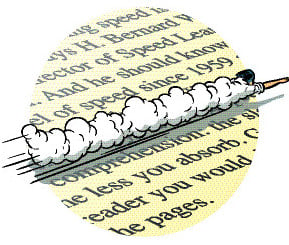
This is why I recommend that all students use this SAT Reading passage strategy:
- Skim the passage on the first read-through. Don't try to understand every single line or write notes predicting what the questions might ask. Just get a general understanding of the passage. You'll want to try to finish reading the passage within three minutes, if possible.
- Next, go to the questions. If the question refers to a certain line number, go back to that line number and work on understanding the text around it.
- If you can't answer a question within 30 seconds, skip it. (More on this strategy later.)
This strategy is important because the questions will ask about far fewer lines than the passage actually contains. For example, lines 5-20 of a reading passage might not be relevant to any question that follows. Therefore, if you spend time trying to deeply understand lines 5-20, you’ll just waste time.
Some students take this strategy to the extreme: they read the questions first before the passage. If a question refers to any specific lines, they then mark those in the passage, which they can later use as a guide to know what to focus on when they read the passage.
Different strategies work for different students. You need to try out a lot to see which strategy leads to the best results for you. But by and large, I'm confident that you're spending way too much time reading the passage.
Strategy 2: Learn to Eliminate the 3 Wrong Answers
I spent some time above talking about how there is always one unambiguously correct answer. This has a huge implication for the strategy you should use to find the right SAT Reading answer.
Here's the other way to see it: out of the four answer choices, three of them have something that is totally wrong about them. Only one answer is 100% correct, which means that the other three are 100% wrong.
You know how you try to eliminate answer choices and then end up with a few at the end that all seem equally likely to be correct?
Well, you're not doing a good enough job of eliminating answer choices. Remember, every single wrong choice can be crossed out for its own reasons.

You have to learn how to eliminate three answer choices for every single Reading question.
"Great, Allen. But this doesn't tell me anything about how to eliminate answer choices."
Thanks for asking. There are a few classic wrong answer choices the SAT loves to use. Let's look at an example.
Imagine you just read a passage that focuses on how human evolution shaped the environment. It gives a few examples. First, it talks about how the transition from earlier species like Homo habilus to neanderthals led to more tool usage like fire, resulting in wildfires and shaping the ecology. It then discusses Homo sapiens 40,000 years ago and their overhunting of species, such as woolly mammoths, to extinction.
After, we run into a question asking, "Which of the following best describes the main subject of the passage?" Here are our possible answer choices:
- A: The transition between Homo habilus and neanderthals
- B: The study of evolution
- C: How the environment shaped human evolution
- D: The plausibility of evolution
- E: The influence of human development on ecology
Note that we're using five answer choices for illustration purposes only—in reality, the SAT only has four answer choices per Reading question.
As you're reading these answers, a few of them probably started to sound really plausible to you.
Surprise! Each of the answers from A to D has something seriously wrong with it. Each one is a classic example of a wrong answer type given by the SAT. Let's look at just what these are.

Wrong Answer 1 (A): Too Specific
A: The transition between Homo habilus and neanderthals
This type of wrong answer focuses on a smaller detail in the passage. It’s meant to trick you and make you think to yourself, "Well, I saw this mentioned in the passage, so it’s a plausible answer choice."
Wrong! Ask yourself: can this answer choice really describe the entire passage? Can it basically function as the title of this passage?
In the end, you’ll find that it’s just way too specific to convey the point of the overall passage.

Wrong Answer 2 (B): Too Broad
B: The study of evolution
This type of wrong answer has the opposite problem as the one above in that it’s way too broad. While theoretically the passage concerns the study of evolution, it focuses on just one aspect of it, especially as it relates to the impact of evolution on the environment.
To give another ludicrous example, say you talked to your friend about your cell phone and he said your main point was the universe. Yes, you were talking about the universe in that you both live in the universe, but this was clearly only a tiny fraction of your conversation.
In short, answer choice B is simply far too general to be a good answer to this question.
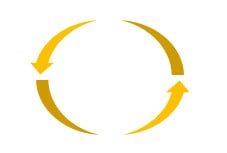
Wrong Answer 3 (C): Reversed Relationship
C: How the environment shaped human evolution
This wrong answer choice can be tricky because it mentions all the right words. But of course the relationship between these words needs to be correct as well. Here, the relationship is flipped: the passage focuses on how human evolution shaped the environment, not the other way around.
Students who read too quickly often make careless mistakes like these!

Wrong Answer 4 (D): Unrelated Concept
D: The plausibility of evolution
Finally, this kind of wrong answer preys on students' tendency to overthink questions. If you’re passionate about arguing about evolution, for example, this answer might be a trigger answer for you since any discussion concerning evolution becomes a chance to argue about its plausibility.
Of course, even though this concept appears nowhere in the passage, some students just aren't able to resist choosing this answer choice.
Do you see the point? On the surface, each answer choice sounds as though it could possibly be correct. But possibly isn't good enough. The right answer must be 100%, totally right. Wrong answers might be off by even just one word, so you need to know how to eliminate these.
Carry this thought into every SAT Reading passage question you do.

Strategy 3: Find Your Reading Skill Weaknesses and Drill Them
Reading passage questions might look similar, but they actually test very different skills. Here at PrepScholar, we believe the major skills tested in SAT passages are as follows:
- Big Picture/Main Point
- Little Picture/Detail
- Inference
- Vocabulary in Context
- Function
- Author Technique
- Evidence Support
- Data Interpretation
- Analyzing Multiple Texts
Whew, that's a lot of skills! More than is obvious when you're reading passages on SAT Reading.
Each of these question types uses different skills in how you read and analyze a passage. They each require a different method of prep and focused practice.
If you're like most students, you're probably better at some areas in Reading than you are at others. For instance, you might be good at getting the big picture of a passage but not so good at getting inferences. Or you might be really strong at pinpointing the author's tone but struggle with interpreting data correctly.
If you're like most students, you also don't have an unlimited amount of time to study. You have a lot of homework, possibly sports and other extracurriculars, and friends to hang out with.
This means that for every hour you study for the SAT, it needs to be the most effective hour possible.
In more concrete terms, you need to find your greatest areas of improvement and work on those.
Too many students study the "dumb" way. They just buy a book and read it cover to cover. When they don't improve, they're shocked.

But I'm not.
Studying effectively for the SAT isn't like painting a house. You're not trying to cover all your bases with a very thin layer of understanding.
What these students did wrong was that they wasted time on subjects they already knew, and they didn't spend enough time on honing their weaknesses.
Studying effectively for the SAT is like plugging up the holes in a leaky boat. You need to find the biggest hole and fill it. Then, you need to find the next biggest hole and fill that, too. You'll soon find that your boat isn't sinking anymore.
How does this relate to SAT Reading? You need to find the sub-skills you're weakest in and then drill those until you're no longer weak in them. Fixing up the biggest holes.
Within Reading, you must figure out whether there are patterns to your mistakes. Is it that you're running out of time with reading passages? Or that you don't get Inference questions? Or that you're really weak at interpreting details?
For every question you miss, identify what type of question it is. When you notice patterns to the questions you miss, you must then devote extra practice to those sub-skills.
Say you miss a lot of Inference questions (this is typically the hardest type of question for students to get on SAT Reading). You need to somehow get focused practice questions for this skill so you can drill your mistakes.
Strategy 4: Only Use High-Quality SAT Reading Sources
SAT Reading passages are very specific in how they work. And SAT Reading questions are very specifically phrased and constructed to have bait answers.
If you want to improve your Reading score, you have to use realistic SAT Reading sources. If you don't, you'll develop bad habits and accidentally train the wrong skills.
Think about it like this: say you're trying out for the baseball team. Instead of practicing with real baseballs, you decide to practice with Wiffle balls. It's a lot cheaper and easier, and hitting the ball makes you feel good about your skills.
So you train and train and train with a Wiffle ball. You understand how the Wiffle ball curves when it's thrown, how to hit it, and how to throw it.
Eventually, you try out for the baseball team. A pitch comes, but it's way faster than you've ever practiced with. It doesn't curve like a Wiffle ball does.
Swing, and a miss.
You've trained with the wrong thing, and now you're totally unprepared for baseball.
 This is not real baseball.
This is not real baseball.
SAT Reading works the exact same way. Train with poorly written tests, and you'll develop bad habits and unhelpful strategies.
Far and away, the best sources for SAT Reading passages are official SAT practice tests. This is why we include these official practice tests in our SAT prep program—so that we can accurately gauge your progress and provide you with quality training.
The problem is that there aren't that many official SAT practice tests available. Because you want to use these to train your endurance for the full-length test, it's best to try to conserve them.
This means that to get enough SAT Reading practice, you'll need to use other materials, too.
Our first suggestion is to use prep resources specifically geared toward the SAT. Be careful, though, since many test-prep companies tend to release poor-quality passages and questions (most books you see on SAT Reading are pretty terrible, too). Check out our picks for the best SAT prep books here.
This is especially harmful for SAT Reading because the style of its passages and questions are quite complex, as opposed to SAT Math whose questions are more straightforward.
To write realistic questions, you need to understand the SAT inside and out. That's why we've created what I believe are the highest quality Reading questions available anywhere. Here's what we've done:
- We've deconstructed every official SAT practice test—question by question, answer by answer. We've statistically studied every question type on the test and understand exactly how questions are phrased and how wrong answer choices are constructed.
- As head of product, I'm responsible for content quality. I hire only the most qualified content writers to craft our test content. This means people who got perfect SAT scores, who have hundreds of hours of SAT teaching experience, and who graduated from Ivy League schools.
All of this results in the most realistic, highest quality SAT Reading questions.
Even if you don't use PrepScholar, make sure that whatever resource you do use undergoes the same scrutiny we exercise. If you're not sure how helpful something is or notice lots of negative reviews, it's best to avoid it.
Strategy 5: Don't Focus On Vocab
Vocab gets way too much attention from students. It feels good to study vocab flashcards because it seems like you're making progress. "I studied 1,000 vocab words—this must mean I improved my Reading score!"
This is why other test-prep programs love teaching you vocab—you feel as though you're learning something and it's worth your money. But the truth is that learning vocab isn't really helping you.
Fortunately, vocab doesn't play a big role in your SAT Reading score anymore.
This is especially true for the current version of the SAT, which no longer has Sentence Completion questions. (On the old, pre-2016 SAT, these were the questions that required you to fill in blanks with vocab words.)
The reasoning behind this decision was that the College Board received a lot of criticism for forcing students to memorize advanced vocab that wasn't that useful in college or for future careers. (And students rejoiced everywhere!)
That said, there are still some SAT Reading questions that ask about vocab, such as this one (taken from an official SAT practice test):
As used in line 68, "hold" most nearly means
A) maintain
B) grip
C) restrain
D) withstand
Wait—"hold"? They're asking a question about the simple word "hold"?
Yes, it's a common word—but the key to this question lies in understanding how a word is used in context. Hold can mean all the things listed in the answer choices, but only one of them is correct.
Here are examples of words you'll need to understand in context for the SAT:
- ambivalent
- convey
- lament
- postulate
These are somewhat advanced words, but they're nowhere near the level of the words you used to have to know, such as "apportionment" and "expropriated."
If you have a pretty typical vocabulary of an American teen, there will be at most two to three SAT Reading questions that'll really stretch your vocabulary. But like I mentioned above, you can miss 16 out of 52 questions and still get a 30 on the Reading section.
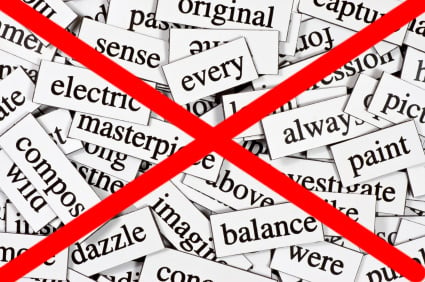
That time is far better spent learning how to deal with Reading passages better. There are so many more questions about passages that it's a better use of your time to learn passage strategy and how to answer reading questions than it is to memorize vocab words.
Strategy 6: Skip the Most Difficult, Time-Consuming Questions
Here's an easy strategy most students don't do enough.
Remember what I said above about raw score? To score a 30 (600) on SAT Reading, you only need a raw score of 36—that's just 36 correct answers out of 52 questions.
But what does this mean for your strategy exactly? You can completely guess on 20 questions, get five of them right by chance, and still score a 600 on Reading.
Once again, you can completely guess on 40% of all questions and still hit your goal!

Why is this such a powerful strategy?
It gives you way more time on easy and medium difficulty questions—the questions you have a good chance of getting right.
If you're usually pressed for time on SAT Reading, this will be a huge help.
Here's an example: on the Reading section, you get 65 minutes to answer 52 questions. This is usually pretty hard for most students to get through, as it's just 75 seconds per question.
The average student will try to push through all the questions. "I've got to get through them all since I've got a shot at getting each question right," they think. Along the way, they rush and make careless mistakes on questions they should have gotten right. And then they spend five minutes on really hard questions, causing them to make no progress and waste time.
Wrong approach.
Here's what I suggest instead. Try each question, but skip it after 30 seconds if you're still not getting anywhere. Unlike math, Reading questions aren't ordered by difficulty, so you can't tell right away which questions are harder or easier. This is why you should try out each one but move on if it's costing you too much time.
By doing this, you can raise your time per easy/medium question to 100 seconds per question or more. This is huge! It's a 30% boost to the time you get per question. As a result, this raises your overall chances of getting easy/medium questions right.
And the questions you skipped? They're so hard you're honestly better off not even trying them. These questions are meant for 700-800 scorers. If you get to 600, you have the right to try them out—but not before you get to 600.
How do you tell which questions are going to take you the most time? This varies from person to person, but here are two question types that commonly take more time than others:
- Questions without line numbers that make you hunt for details: You can spend a lot of time rereading the passage looking for where Virginia Woolf mentioned a staircase.
- Questions that ask you to compare two passages: If you really struggle to understand passages, paired passages will be twice the trouble.
Do your SAT Reading prep with all of this in mind. If you get stuck on a question, think about what type of question it is, and figure out whether there's a pattern to the questions that consistently trip you up.
Strategy 7: Understand All Your Reading Mistakes
Every mistake you make on a test happens for a reason. If you don't understand exactly why you missed a question, you'll make the same mistake over and over again.
Too many students scoring at the 400-600 level on SAT Reading refuse to study their mistakes.
It's harsh. I get it. It sucks to stare your mistakes in the face. It's draining to learn difficult concepts you don't readily understand.
So the average student will skip reviewing their mistakes and instead focus on the areas they're already comfortable with. It's like a warm blanket. Their thinking goes like this: "So I'm good at Big Picture questions? I should do more Big Picture problems! They make me feel good about myself."
The result? No score improvement.
You don't want to be like these students. So here's what you need to do instead:
- On every practice test or question set you take, mark every question you're even just 20% unsure about.
- When you grade your test or quiz, review every question you marked and every incorrect question. This way even if you guessed a question correctly, you'll make sure to review it.
- In a notebook, write down the gist of the question, why you missed it, and what you'll do to avoid making that mistake in the future. Have separate sections by subject and sub-topic (e.g., Big Picture, Inference, Vocab, etc.).
It's not enough to just think about it and move on. It's not enough to just read the answer explanation. You have to think hard about why you specifically failed on a question.
For Reading questions, you must find a way to eliminate every single incorrect answer. If you were stuck between two answer choices, review your work to figure out why you couldn't eliminate the wrong answer choice.
If you don't do this, I guarantee you will not make any progress.
But if you do take this structured approach to your mistakes, you'll now have a running log of every question you missed as well as your reflections on why you made the mistakes you did.
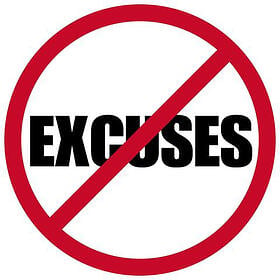
No excuses when it comes to your mistakes.
Strategy 8: Guess on Every Question You Don't Know
You might already know this one, but if you don't, you're about to earn some serious points.
The SAT does not have a wrong answer penalty.
On the old SAT, each wrong answer deducted 0.25 points from your raw score. This required you to have a smart guessing strategy.
But no longer! Now, there is no penalty for getting a wrong answer. This means there's no reason to leave any question blank.
So before you finish the Reading section, make sure every blank question has an answer filled in. You don't want to look at your answer sheet and see any blank questions.
For every question you're unsure about, make sure you guess as best you can. If you can eliminate even just one answer choice, you'll have a much better shot at getting it right.
If you have no idea, just go ahead and guess! You have a 25% chance of getting it right anyway.
Most people know this strategy already, so if you don't do this, you're at a serious disadvantage.
Overview: Tips for Raising Your Low SAT Reading Score
Those are the main strategies you should use to improve your SAT Reading score. If you're scoring around 350, you can use these to get to 500. If you're scoring around 470, boost your score to 600. I guarantee it—as long as you put in the right amount of work and study as I suggest above, you're bound to hit your goal score on test day.
The main point, though, is this: you need to understand where you're falling short and drill those weaknesses continuously. You also need to be thoughtful about your mistakes and leave no mistake ignored.
This is really important for your future. Make sure you give SAT prep the attention it deserves—before it's too late and you get a rejection letter you didn't want.
Finally, if you want to go back and review any of the above strategies, here's a quick listing:
- Strategy 1: Save Time on Reading Passages by Switching Your Reading Strategy
- Strategy 2: Learn to Eliminate the 3 Wrong Answers
- Strategy 3: Find Your Reading Skill Weaknesses and Drill Them
- Strategy 4: Only Use High-Quality SAT Reading Sources
- Strategy 5: Don't Focus On Vocab
- Strategy 6: Skip the Most Difficult, Time-Consuming Questions
- Strategy 7: Understand All Your Reading Mistakes
- Strategy 8: Guess on Every Question You Don't Know
What's Next?
We've got a lot of useful guides you can use to raise your SAT section scores. For Math, read my detailed guide to improving your SAT Math score.
You can also learn how to raise your SAT Writing score or your SAT Essay score.
What's a good SAT score for you personally? Use our step-by-step guide to figure out your SAT target score today.




